Aug 10, 2021
WHAT CAUSES SHORELINE EROSION?
Lakeshores are areas of constant dynamic energy. Powerful waves, high water, and ice move soil particles away from shorelines. In more severe cases, small pebbles and eventually rocks begin to wash out. When the water reaches far enough up the shoreline, erosion of lawns and exposing tree roots start.
We’ll try to answer some of your questions today.
What are the leading causes of shoreline erosion?
On open water like Green Bay, the three leading causes of erosions are:
-
- Wave action;
- High water; and
- Ice movement.
The ice on frozen lakes or the Bay can expand towards the shore with a force of many tons per square foot. The ice will destroy most obstacles in its path. Masses of ice put in motion by winds can push trees or buildings over, as exhibited here.
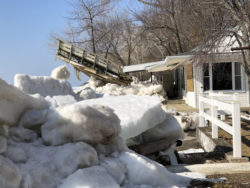
Ice vs deck erosion
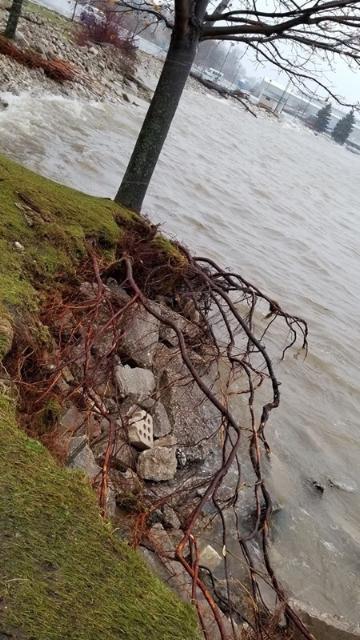
Shoreline tree roots exposed
Ice also pushes embankments, uprooting trees and lawns on small inland lakes. No matter how massive a tree is, the ice won’t slow down for it.
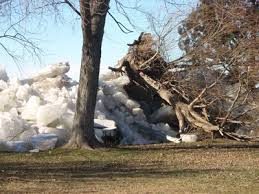
Ice Shove uprooting trees
In relatively small inland lakes, breaking waves can erode lawns away.
Headlands (points) usually have relatively high erosion rates. The waves, currents, and the ice will attack from all three sides. These attacks eventually transport the sediments to a new location where they settle in calmer weather.
Erosion is a normal process of nature.
Erosion and the redistribution of sediments is a natural process along shorelines. Typically, natural erosion proceeds very slowly. The plants and animals that live along the shore can adjust to these slow changes. They maintain a stable, healthy, productive ecosystem.
Accelerated erosion results when natural or human disturbances cause this equilibrium to be upset. Examples of this are higher than normal water levels and intense storms.
Human disturbances include vegetation removal, dredging, filling, or construction near the shoreline.
Another example of natural disturbances is large trees uprooted by a windstorm or a flood. When the soil becomes saturated with water, it weakens the soil around tree roots. The winds may uproot that tree.
IDENTIFY SERIOUS EROSION PROBLEMS
These are several signs of severe erosion problems. (Number one and three are significant)
- A large area of bare soil on a steep, high shoreline bank;
- A measurable change of the shoreline over time;
- Leaning or downed trees with exposed roots; and
- Large patches of muddy water near a lakeshore during periods of high water or following a rainstorm.
3 TYPES OF REACTIVE EROSION CONTROL METHODS:
Vegetative/No Mow: This method involves encouraging or planting trees or woody shrubs for the soil binding properties of their root systems. Grass and other plants will protect against raindrop impact and scouring from surface runoff.
Structural: This includes protective structures. The placement of rock of various sizes (rip-rap) has traditionally been the most effective and least expensive method.
Other structural methods include bulkheads, gabions (rock-filled baskets), and railroad ties. However, these methods are visually unappealing. They require more heavy equipment and technical expertise. These systems are more prone to failure than simple rip-rap. In addition, the DNR has disapproved of these methods in the past.
Manipulative: Mostly used on streams, this includes:
-
-
- Removing streamflow obstructions;
- Grading shoreline banks, or, in exceptional circumstances;
- Rerouting a stream channel.
Are there new techniques developed to prevent erosion?
A new soil preservation method called bioengineering has been proven successful.
Soil bioengineering combines mechanical, biological, and ecological concepts. These methods arrest and prevent shoreline erosion. An example is planting willows interspersed with rip-rap, where the rock provides immediate resistance to decay.
As the willows become established, roots invade and permeate the rock and underlying soil. They bind them together into an erosion-resistant mass. The willows also impart a more “natural” look to the shoreline.
Water levels are down; I don’t have to worry – Right??
This year, people do see water levels about 18-24″ less than in 2020. High water levels are the most significant contributing factor to shoreline erosion.
Will it stay down next year or in the years after? No one knows. In Las Vegas, that’s called a crapshoot.
What other factors affect my shoreline?
The next factor is the intensity of the storms. The Door County Peninsula had numerous high wind storms this year with up to 70 MPH winds.
A popular Marina in Sturgeon Bay: Skipper Bud’s Harbor Marina, located at the foot of the Michigan St. bridge, was a victim of a recent storm.
The marina had two of its five floating docks torn loose during a strong storm. Two tub boats quickly moved in place to prevent them from swinging into the bridge.
Are there other contributing factors to shoreline erosion?
You can expect water levels to rise rapidly when winds blow from the NW – NE direction for prolonged periods. This is despite the lower water levels this year. The stronger the winds, the higher the water will go. Waters south of Sturgeon Bay are particularly affected by these winds. In those areas, there are no other large outlets for the water to escape.
DO YOU NEED AN ESTIMATE FOR RIP-RAP?
Contact Dave@ 920-493-4406 or email at Dave@wisconsinpws.com.
What comes next?
Next week (on Aug 10, 2021), we will cover:
-
-
-
-
- Planning an erosion control project;
- Does erosion hurt my property values?
- What to expect for the cost of rip-rap.
Where is Pier & Waterfront Solutions?
Located at 7325 St. Hwy 57, it’s 3 miles south of Sturgeon Bay and 1 mile past the intersection of Cty MM (heading north). Look on the right side, one mile north, at the next corner (Idlewild Road and Hwy 57).
Is PWS OPEN?
The “Delta” variant is currently surging across the country.
Pier & Waterfront Solutions remains “open.” We have implemented measures to help protect the safety of our employees and visitors. PWS continues to work to maintain the trusted service that you have come to expect.
PWS implemented these preventive measures:
- Conducting as much business as possible by email, text, or phone.
- Site visits will continue.
- When in-person contacts are necessary, we follow “social distancing” guidelines.
- Our display yard is always open for you to examine at your leisure.
- All displays have a numbered, red tag on them. For more information, please reference that number.
What can YOU do to help us?
1. Conduct as much business as possible via emails, messaging, and emails.
2. When you see our crews installing equipment, please practice “social distancing.”
Thank you for allowing us to work with you.
YES – PWS is OPEN and waiting for you!
Please call, message, or email PWS with any questions.
Let’s all stay safe!
Aug 5, 2021
Thanks so much Jerry. Your Customer Service is unparalleled!
Carter R. Door County
Jun 29, 2021
How Long Will a Boat Lift Last?
Your boat is a BIG investment. You want to protect it for years to come. It only makes sense that your boat lift system should last at least as long as your boat. If your boat lift is well-built and maintained, it can last 25 years or more. In general, a boat lift will last much longer if you take care of it.
Look at these areas as part of a regular boat lift maintenance schedule.
Weight Warnings
A properly sized boat lift will handle the weight of your boat plus the equipment you put in it. PWS will assist in selecting the proper size and type of boat lift for your hull and shoreline conditions.
The average boat up to 20′ will weigh in the 4 – 6,000 lb range. This includes the fuel, water, gas, motor(s). Don’t forget your passengers – including your friend – Big Bubba.
Don’t let people get in or out of the boat while it’s on the lift to avoid straining the system. When you’re not using your boat, remove the drain plug at the back of the boat. Rainwater can’t collect and add extra weight (roughly 8 lbs/gallon) if you do. Don’t forget to replace it before you go out again.
Lift Cables and Pulleys
Lubricate your cables with penetrating oil instead of grease. Replace any cables with rust spots, broken strands, fraying, or kinks. Grease the lift pulleys if required. Be sure to check the nuts and bolts to ensure tightness.
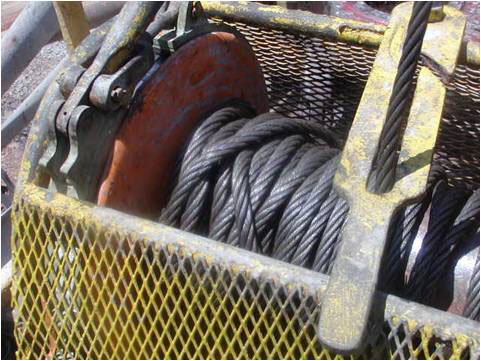
Boatlift cable backlash
Check your winch drum as the cable is winding onto it to avoid slack, misalignment, and uneven wear. Never allow your lift cables to go slack. A slack line will result in damage to the system. It’s like a backlash on a fishing pole, only with a rigid steel cable. It can be challenging to unravel.
Never use a screwdriver or hit the cable with a hammer in an attempt to release the line. You’re almost guaranteed to cause severe damage.
Motors, Gearboxes, and Drive Units
If your boat lift has a motor, examine it for signs of rust or water retention. Ensure that any holes on the top of the motor or winch are closed.
The bottom holes must be open for proper drainage.
Inspect your gearbox and drive units regularly. Check for appropriate alignment, damaged cables, and areas that need lubrication.
Lift beams
Inspect your bunk carpeting for wear and tear and any wood underneath the carpet for cracks and rot. Lift beams should be kept out of the water when not in use. Better yet, get an aluminum/vinyl set and never have to replace the carpeting again.
Keep your hardware tightened, and be sure that the bunks line up correctly with your boat hull.
Storage
If you’re storing your lift in the off-season, remove the battery if you have a power hoist. Store it on a small piece of wood. Store your lift with the cradle or platform to the top.
Your boat lift protects your boat, so it’s essential to keep it in good condition.
Proper care and maintenance can help you avoid costly damage. Your dock and accessories need to be inspected for damage, also. Check your manufacturer’s guidelines for more specific care instructions.
Weight
It’s up to you to stay within the manufacturer’s specifications. Staying within those specs is crucial.
Even lifting a boat with the wrong hull design can cause damage. Never add more weight to your boat while it’s on the lift.
Entering or exiting a boat while it’s on a boatlift can be very dangerous. Ensure you have proper weight distribution when lifting.
Lubrication
Cables are usually made of stainless steel and need lubrication. Regularly apply penetrating oil or chain and cable fluid to reduce abrasion.
Make sure not to use grease on the cables. Grease traps moisture inside the cable strands. However, boat lift motor components and pulleys usually require grease.
Since you’re lubricating your lift, check for damaged cables that need to be repaired, replaced, or tightened.
Water-Related Damage
Boat docks and lifts are still susceptible to water-related damage. Lift beams and bunks can be damaged by a boat coming in “hot.” When docking, check your speed, so you are not going faster than you are willing to hit the dock.
Keep your lift out of the water as much as possible. Small amounts of rust can be ground off and touched up.
Never place a plastic bag or cover over the winch and/or motors in the winter. Condensation will form inside and cause excessive damage.
Alignment
Uneven wear can shorten cable lifespan, so keep an eye on the cable alignment. Make sheave alignment part of your regular inspections. Keep an eye on the winder, drum, and spool.
If you notice a backlashed cable, slack, or other boat lift problems- STOP. Don’t go any further. Adjust the cables immediately. If you’re not sure of the alignment, contact the professionals at PWS.
Reminder – Use leather gloves to protect your hands when handling the cables.
Storage
Even off-season storage can contribute to how long your boat lift lasts. Store your boat lift with the platform up.
If you have a power hoist, remove the battery and store it inside on a small piece of wood.
Signs of Lift Damage
Once the flood or storm has died down, clear any debris off of your dock and lift. Look for bent or twisted beams, damaged drives, or broken bunks on your lift. Look for bent or damaged bolts and loose fasteners.
Check the lift cables for kinks, abrasions, frays, or breaks. Do not operate your lift until those cables are repaired or replaced.
If your boat lift shifted during the storm, realign it and make it square with the dock. When there are high waves, make sure the boat is still in the correct position.
Consult your installation manual or PWS for more information about adjustments. Even if everything looks good, make sure that you perform a test run of your lift. Check for any problems before you get back to boating.
At times large objects, like logs or other debris, strike your boatlift during the night or when you are away. Always look for damage if there was a storm.
ShoreMaster boat lifts are made with premium components. They make the best equipment to protect your boat.
In summary
Invest in the best boat lift brand to protect your boat – ShoreMaster.
Where can you find Pier & Waterfront Solutions?
Pier & Waterfront Solutions, 7325 St. Hwy 57, is located 3 miles south of Sturgeon Bay. Go 1 mile PAST the intersection with County MM (heading north). Look on the right at the intersection of Idlewild Road and Hwy 57.
PWS is

Pier & Waterfront Solutions remains “open” year-round.
The Covid-19 virus is waning thanks to the population getting vaccinations. We hope that the remaining people will get the vaccine to help stop the spread of this deadly virus. We will continue to conduct as much business as possible by email, text, or phone to do our part to keep people safe.
Site visits continue as usual. When making in-person contacts, we follow “social distancing” guidelines when possible by doing any face-to-face contact outdoors.
PWS display yard – OPEN 24-7
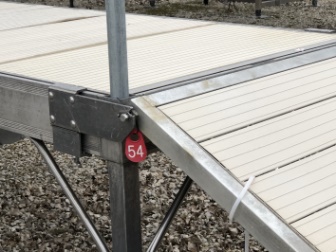
Red Tag
PWS‘s display area is always open for you to examine at your leisure. All displays available for sale have a numbered, red tag on them. Want more information on something you saw in our yard? Please reference that number when you inquire.
PWS provides estimates by email to make the process faster, safer, and paperless.
Call, message, or email Jerry with any questions.

Jerry Englebert
Contact Jerry at 920-493-4404 for more information or use this link.
Jun 22, 2021
Replacement Canopy Covers
Your boat lift is in the water, and you are ready for a great summer of boating. Have you taken your first cruise this year? Yes! It was a great experience – wasn’t it?
That is until you noticed the hole(s) in your canopy cover. Did the last storm cause a tear in your canopy? You can’t ignore it. It’s time to replace your top!
Wait!!
Your previous boat lift dealer went out of business, or you don’t remember what size canopy you need! Contact PWS.
Customer referrals
By now, you’ve heard great comments about Pier & Waterfront Solutions. There are over 100 customer referrals on the PWS website, demonstrating the quality of our work. Those are not some salesperson’s words – they are actual, documented statements.
Testimonials like:
Mike W, Fish Creek
Sorry for the delayed message but I wanted to compliment your crew for the AMAZING dock installation they did this year!
These young men (Alex and Tyler) did the best install I have ever seen! I am a perfectionist, and I could not have done a better job myself! Even the pipes that are across from each other are even in height where in the past the pipes were all at random heights,
We tipped the guys but I wanted you to know what a great job they did! Keep up the great work!! Mike W
Excellent Job
Hi Jerry, Enclosed is payment for the pier haul out this fall ….. They (the crew) did an excellent job under difficult conditions. Will call you next spring for re-installation. Dave W.
Great Job John K Door County
Crews do a great job. John K.
Awesome Service – Casey C.
Jerry, Thank you so much for the AWESOME service! Casey C.
Here’s More
Hi = just wanted to let you know your crew did a great job taking down our dock this year. You are all a pleasure to work with. Thanks David C.
QB Outstanding Project Work
Outstanding project work. Alex is magical on the forklift and Ben is a strong extra. Nice work, it’s exactly as I hoped it would turn out. QB
Dale R. Customer service is an art
Jerry, Customer service is an art. You have mastered the art. Thank you for your service! Dale R.
We appreciate you
Hi Jerry, I just want you to know how much we appreciate everything you do. It is always a pleasure to work with you. Katie R.
I enjoyed talking to Keri
I enjoyed talking with Keri. She is very polite and personable. She relayed exactly what I wanted done and she will do well for your business. Please share this with her. Thanks Michael H
Repair Parts
You also know that PWS can provide replacement parts for almost all dock and boat lift brands. But did you know PWS can provide replacement canopies for every brand of boat lift?
Here’s a complete list of boat lift canopies available:
(alpha order)
-
-
-
-
-
-
-
- Beach King
- Daka
- DockRight
- Floe
- Harbormaster
- Hewitt
- LakeShore
- Newman’s
- Vibo
- Pier Pleasure
- Porta-Dock
- ShoreMaster
- Shorestation
LOVE YOUR BOAT?
Love your boat? Then you want to give it a dry home.
Many boat owners choose ShoreMaster Boat Lift Canopies to protect their boats. The quality and longevity of its products are synonymous with the name – ShoreMaster.
ShoreMaster Boat Lift canopies last for years, giving your boat the protection it needs and deserves.
Due to the quality of a ShoreMaster canopy frame, you don’t have to worry about them. But, the sun does deteriorate all canopy fabrics over time.
Which brands are popular on the Door County Peninsula?
The two popular boat lift brands on the Door County peninsula are ShoreMaster and Shorestation. We’ll concentrate on those.
Measuring for ShoreMaster Canopy Covers
First, it’s important to remember that ShoreMaster has more than one length for each lift. Different fabrics and colors are also available for every model.
Telling us you have a model # SM 4010 lift is not enough. Here is the correct way to measure a replacement canopy for a ShoreMaster boat lift:
- Refer to the diagram below for detailed information on the needed measurements.
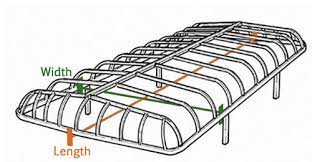
ShoreMaster Canopy Dimensions
Length: Measure from the frame outside edge to the outside edge, along the horizontal centerline. Do not measure up and over the top.
Width: Measure between the inside edges of the frame.
What about the Shorestation brand?
Shorestation lifts will have an extra factor to consider – The metal used on the canopy frame. Shorestation makes canopy frames with either steel or aluminum. It’s important to distinguish between the two before proceeding. The shape and mountings are different.
Older “legacy” models used steel for the frames. Later they began making aluminum boat lifts like the rest of the world.
Now we have the frame material down pat. Now we can ask the remaining questions. We’ll start with the aluminum lifts since they are the most popular.
Shorestation ALUMINUM Canopy Frames

Shorestation Aluminum Canopy Dimensions
Length: Measure the side rail and then add 2 feet to that number
Width: Measure between the inside edges of the frame
Now on to the Steel canopies.
Shorestation STEEL Canopy Frames

Shorestation Steel Canopy Dimensions
Length: Count the number of inner ribs
Width: Measure between the inside edges of the frame
NOTE: Were there ANY modifications or repairs to the canopy frame? If the answer is yes, it is vital to bring that information to our attention. Changes could result in an error. Custom canopy sizes are not returnable.
Want assurances that the new canopy will fit?
The best option is to have a PWS representative do a site evaluation by coming to your site. That way, you can rest assured that we have the correct information.
Not either brand?
Look for the brand name on the frame or winch of the boat lift and call or send the information to us. Sending a photo helps also.
We will return a diagram of the frames to compare with your actual canopy frame. We will also show you how to take the precise canopy dimensions needed. It’s as simple as that!
If in doubt, ask PWS to send someone out to get the information.
SUMMARY
It’s better to be safe than sorry – Call PWS Today!
Where can you find Pier & Waterfront Solutions?
Pier & Waterfront Solutions, 7325 St. Hwy 57, is located 3 miles south of Sturgeon Bay. Go 1 mile PAST the intersection with County MM (heading north). Look on the right at the intersection of Idlewild Road and Hwy 57.
PWS is

Pier & Waterfront Solutions remains “open” year-round.
The Covid-19 virus is waning thanks to the population getting vaccinations. We hope that the remaining people will get the vaccine to help stop the spread of this deadly virus. We will continue to conduct as much business as possible by email, text, or phone to do our part to keep people safe.
Site visits continue as usual. When making in-person contacts, we follow “social distancing” guidelines when possible by doing any face-to-face contact outdoors.
PWS display yard – OPEN 24-7

Red Tag
PWS‘s display area is always open for you to examine at your leisure. All displays available for sale have a numbered, red tag on them. Want more information on something you saw in our yard? Please reference that number when you inquire.
PWS provides estimates by email to make the process faster, safer, and paperless.
Call, message, or email Jerry with any questions.

Jerry Englebert
Contact Jerry at 920-493-4404 for more information or use this link.
Jun 15, 2021
Why Is A Lead Acid Battery used?
For years, the battery of choice for boat motors has been the lead-acid type. New technology will someday lower lithium battery prices, and boaters will change over to the latest technologies. In the meantime, boat owners will continue to be stuck with the old, heavy lead-acid batteries we use today.
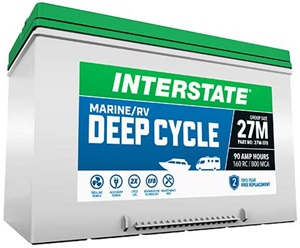
Deep Cell Marine Battery
At this point, they are still the least expensive source of energy available. We have to take care of the battery to get the most out of it and make sure it has enough stored power when we need it. You can’t start your engine or operate the lift motor with a dead battery.
PWS recommends the Interstate deep-cycle Marine Battery line.
We will be discussing boats running 12 and 24-volt battery systems to power a boat or a lift motor in this post.
How do you know if a battery has a full charge?
A fully charged battery, not connected to anything, will read 12.8 volts. A battery at half charge reads 12.2 volts, and a dangerously low unit will read 11.8 volts. It leaves little room for error with readings that close together. Keeping your boat battery charged is vital.
What happens to a less than fully charged battery?
Lead-acid batteries will discharge over time. The damp, cool environment of a boat only accelerates the process. If left in a discharged state, they have a high chance of having permanent damage – at the very least, shortening its lifespan.
Just because there are no moving parts doesn’t mean that it cannot be damaged and fail. Individual cells within a battery may collapse, rendering the entire battery useless.
Some form of charging system is mandatory for every battery. The charging system isn’t just a matter of buying the cheapest, smallest charger from a local auto shop. A charger like that usually won’t make it through the first season in a marine environment.
Like everything else that has to work on your boat, It’s needs to be designed specifically for these conditions. The best brands understand this and make their product accordingly.
A 10 amp charger shoved ten amps into your battery in the old days – whether it needed it or not. If you left it plugged in, you run the risk of ‘cooking’ the cells dry. The water evaporates, and the cells short out.
The advent of “staged” chargers changed all that. The staged chargers (like solar chargers) were designed to be attached 24/7. The chargers cycle through a series of steps that condition the battery and prolong its life. The proper charger will pay for itself the next time you don’t have to replace your batteries.
Trickle Chargers
Trickle chargers are great for motorcycle or jet ski batteries. However, an average-sized boat battery requires extra “Umph” if used frequently. Even the deep cell marine battery needs charging after use. Opinions vary but don’t waste your time with anything less than a 10 amp charger.
WHAT SIZE CHARGER DO I NEED?
Do you have two batteries for operating a lift motor? A regulator will spread the charge between the batteries as each battery becomes fully charged.
As a side note, using (2) deep cell marine batteries will increase the speed of the boat lift mechanism. Sorry, it will increase the speed but not by 2x.
Solar Panels
Solar panels are a completely different discussion. Their progress has been steadily improving efficiency. Each year there are improvements to their performance.
Keeping your Battery Terminals Clean
Keep your batteries clean – particularly the terminals.
There are liquids and sprays to protect your terminals from corrosion. These liquids will also safeguard any connections mounted to the terminals—no more of that nasty green stuff.
Keeping the terminals clean will keep a good flow of electricity to those motors when they need it. These liquids and sprays will also make it easy to remove your batteries should the need arise.
MY MOTOR WON’T START – How do I know if it’s a bad battery connection?
Like a car in the middle of winter, if you get a stuttering sound when trying to start your boat, it means the connections at the battery need cleaning. Continuing to try to start the motor will only draw down the battery power further. Watch for the lights dimming when you try to start the engine. A corroded connection will cause the lights to dim.
SUMMARY
Hopefully, this information gives you a better understanding of batteries and makes your boating life easier and more enjoyable.
Where can you find Pier & Waterfront Solutions?
Pier & Waterfront Solutions, 7325 St. Hwy 57, is located 3 miles south of Sturgeon Bay. Go 1 mile PAST the intersection with County MM (heading north). Look on the right at the intersection of Idlewild Road and Hwy 57.
PWS is

Pier & Waterfront Solutions remains “open” year-round.
The Covid-19 virus is waning. We hope people will continue to get the vaccine to help stop the spread of this deadly virus. We will continue to conduct as much business as possible by email, text, or phone to do our part to keep people safe.
Site visits continue as usual. When making in-person contacts, we follow “social distancing” guidelines when possible by doing any face-to-face contact outdoors.
PWS display yard – OPEN 24-7

Red Tag
PWS‘s display area is always open for you to examine at your leisure. All displays available for sale have a numbered, red tag on them. Want more information on something you saw in our yard? Please reference that number when you inquire.
PWS provides estimates by email to make the process faster, safer, and paperless.
Call, message, or email Jerry with any questions.

Jerry Englebert
Contact Jerry at 920-493-4404 for more information or use this link.
















